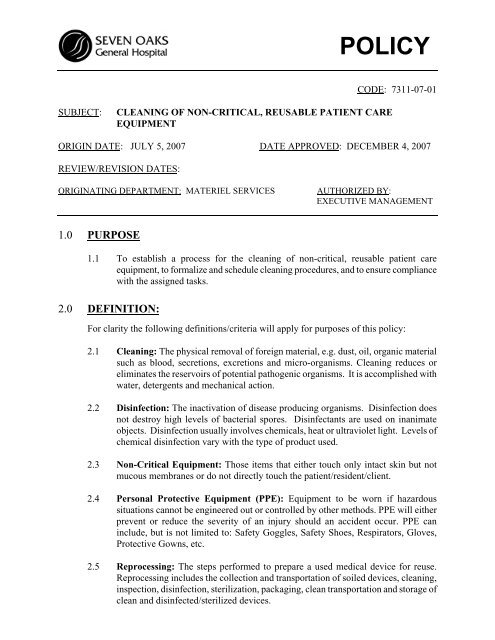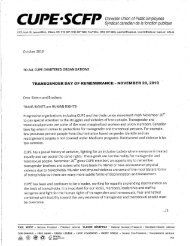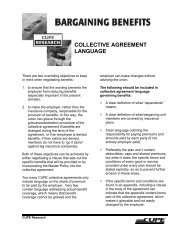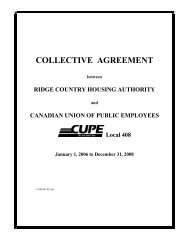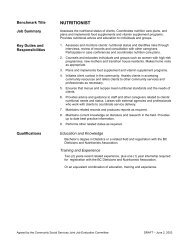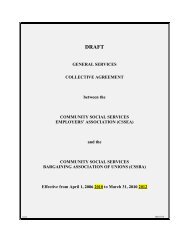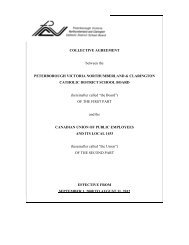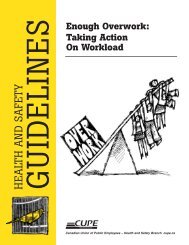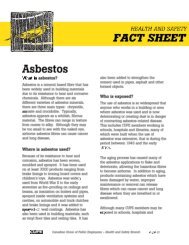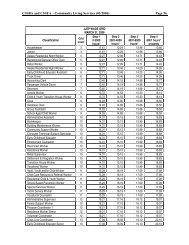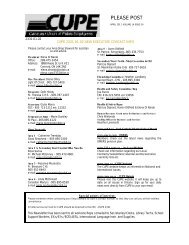ECS Cleaning Policy SOGH
ECS Cleaning Policy SOGH
ECS Cleaning Policy SOGH
You also want an ePaper? Increase the reach of your titles
YUMPU automatically turns print PDFs into web optimized ePapers that Google loves.
POLICY<br />
CODE: 7311-07-01<br />
SUBJECT:<br />
CLEANING OF NON-CRITICAL, REUSABLE PATIENT CARE<br />
EQUIPMENT<br />
ORIGIN DATE: JULY 5, 2007 DATE APPROVED: DECEMBER 4, 2007<br />
REVIEW/REVISION DATES:<br />
ORIGINATING DEPARTMENT: MATERIEL SERVICES<br />
AUTHORIZED BY:<br />
EXECUTIVE MANAGEMENT<br />
1.0 PURPOSE<br />
1.1 To establish a process for the cleaning of non-critical, reusable patient care<br />
equipment, to formalize and schedule cleaning procedures, and to ensure compliance<br />
with the assigned tasks.<br />
2.0 DEFINITION:<br />
For clarity the following definitions/criteria will apply for purposes of this policy:<br />
2.1 <strong>Cleaning</strong>: The physical removal of foreign material, e.g. dust, oil, organic material<br />
such as blood, secretions, excretions and micro-organisms. <strong>Cleaning</strong> reduces or<br />
eliminates the reservoirs of potential pathogenic organisms. It is accomplished with<br />
water, detergents and mechanical action.<br />
2.2 Disinfection: The inactivation of disease producing organisms. Disinfection does<br />
not destroy high levels of bacterial spores. Disinfectants are used on inanimate<br />
objects. Disinfection usually involves chemicals, heat or ultraviolet light. Levels of<br />
chemical disinfection vary with the type of product used.<br />
2.3 Non-Critical Equipment: Those items that either touch only intact skin but not<br />
mucous membranes or do not directly touch the patient/resident/client.<br />
2.4 Personal Protective Equipment (PPE): Equipment to be worn if hazardous<br />
situations cannot be engineered out or controlled by other methods. PPE will either<br />
prevent or reduce the severity of an injury should an accident occur. PPE can<br />
include, but is not limited to: Safety Goggles, Safety Shoes, Respirators, Gloves,<br />
Protective Gowns, etc.<br />
2.5 Reprocessing: The steps performed to prepare a used medical device for reuse.<br />
Reprocessing includes the collection and transportation of soiled devices, cleaning,<br />
inspection, disinfection, sterilization, packaging, clean transportation and storage of<br />
clean and disinfected/sterilized devices.
Page 2 of 5 CODE: 7311-07-01<br />
SUBJECT: CLEANING OF NON-CRITICAL,<br />
REUSABLE PATIENT CARE EQUIPMENT<br />
2.6 Reusable Equipment: A device that has been designed and tested by the<br />
manufacturer, that is suitable for reprocessing prior to use on a<br />
patient/resident/client.<br />
2.7 Routine Practices: A set of infection control precautions and practices used for all<br />
direct care, regardless of the patient’s presumed infection status or diagnosis.<br />
3.0 POLICY:<br />
3.1 In accordance with existing infection control policies and procedures, Seven Oaks<br />
General Hospital will implement and maintain processes to ensure all non-critical,<br />
reusable patient care equipment is routinely cleaned before and after reuse. <strong>Cleaning</strong><br />
is a shared responsibility between Clinical Programs, Materiel Services and Allied<br />
Health. Procedures will address in particular, the following issues:<br />
• All equipment must be cleaned immediately if visibly soiled, and immediately<br />
after use on patients with contact precautions (e.g. MRSA, VRE, and c-difficile)<br />
regardless of cleaning schedule.<br />
• Patient care equipment should be dedicated to the use of a single patient and<br />
cleaned, disinfected and/or reprocessed before reuse with another patient.<br />
• Items routinely shared, which cannot be cleaned between uses, will follow a<br />
regular schedule for cleaning and disinfection.<br />
• <strong>Cleaning</strong> and maintenance processes will follow manufacturer’s<br />
recommendations.<br />
• The application of tape on patient care equipment should be discouraged.<br />
• All health care workers must exercise routine practices (i.e. hand hygiene) and<br />
wear the required PPE appropriate for the task.<br />
• Any damaged equipment must be reported to the department manager for<br />
decision regarding replacement or the ability to clean.<br />
• Special, additional cleaning may be required in an outbreak situation. Procedures<br />
will be determined in consultation with the Infection Control Practitioner.<br />
• Disposable patient care equipment and supplies shall be immediately discarded<br />
after use.<br />
• Personal care items/effects (such as lotions, razors, skin cleansers) are single use<br />
patient items and are not to be shared between patients.<br />
• All horizontal and frequently touched surfaces shall be cleaned daily and<br />
immediately when soiled.<br />
• The Standardization Committee and the Infection Control Practitioner must<br />
approve all products used for any/all stages of the cleaning /disinfection process.
Page 3 of 5 CODE: 7311-07-01<br />
SUBJECT: CLEANING OF NON-CRITICAL,<br />
REUSABLE PATIENT CARE EQUIPMENT<br />
4.0 PROCEDURE:<br />
4.1 The following products are currently acceptable for the cleaning of non-critical,<br />
reusable patient equipment:<br />
• PerCept – 1:16 General Virucidal Disinfectant Cleaner<br />
(Accelerated Hydrogen Peroxide) for<br />
disinfecting non-critical items and equipment<br />
• PerCept RTU Wipes Ready-to-Use General Virucidal Disinfectant<br />
Cleaner (Accelerated Hydrogen Peroxide) for<br />
disinfecting non-critical items and equipment<br />
• PerDiem – 1:64 Hard Surface Cleaner Disinfectant (Stabilized<br />
Hydrogen Peroxide) for all hand contact and<br />
wet damp areas (e.g. call buttons, railings, etc.)<br />
– mainly used by Environmental <strong>Cleaning</strong><br />
Services (<strong>ECS</strong>)<br />
• Adhesive Tape Remover Pads<br />
• Non-Sterile Gloves<br />
• Personal Protective Equipment as required<br />
4.2 The Seven Oaks General Hospital has adopted three different cleaning procedures<br />
for non-critical, reusable patient care items. The applicable procedure depends on<br />
the product type, product material and/or surface:<br />
• Procedure A: for wipeable equipment made of metal, plastic, vinyl, wood,<br />
leather or rubber (i.e. IV poles, infusion pumps, diagnostic imaging equipment,<br />
monitoring equipment, wheelchairs)<br />
• Procedure B: for hard to clean items made of fabric, paper, foam or similar<br />
materials (i.e. wheelchair cushions, sliders, slings)<br />
• Procedure C: for specialty items that are sensitive to the excessive use of<br />
standard cleaner/disinfectant (i.e. pulse oximeters, television sets, LCD<br />
screens, DVD players, VCR’s)
Page 4 of 5 CODE: 7311-07-01<br />
SUBJECT: CLEANING OF NON-CRITICAL,<br />
REUSABLE PATIENT CARE EQUIPMENT<br />
4.2.1 PROCEDURE A<br />
Step Task<br />
1. Use PPE as required. Put on a new pair of disposable<br />
gloves. Start with a fresh cleaning cloth.<br />
2. Remove all tape and tape residue with adhesive remover.<br />
(Equipment is not considered clean unless all tape residue<br />
has been removed.) Pre-soak with PerDiem or PerCept<br />
and use mechanical action to remove all visible soil.<br />
Grooves on equipment may require cleaning with a<br />
cleaning brush. Avoid the use of hard instruments for<br />
cleaning.<br />
Please note: <strong>SOGH</strong> ID Tags (asset numbers) are not to<br />
be removed.<br />
3. Soak clean cloth in PerCept – wet but not dripping, or use<br />
RTU PerCept Wipes. Do not spray cleaner/disinfectant<br />
directly onto monitoring equipment or infusion pumps.<br />
4. Wipe equipment thoroughly, avoiding any electrical or<br />
electronic connectors to prevent malfunction.<br />
5. Let air dry.<br />
Please note: The virucidal disinfectant cleaner PerCept<br />
requires a 5-minute contact time to be effective.<br />
6. Clean numeric display with a dry cloth.<br />
4.2.2 PROCEDURE B<br />
Material Task<br />
Cardboard/ Wipe laminated cardboard/paper with PerCept. All other<br />
Paper cardboard/paper shall be discarded after use.<br />
Fabric Follow manufacturer’s instructions. Most fabrics require<br />
machine washing and drying at specified drying<br />
time/temperature in a gas/electric dryer. Bleach shall not<br />
be added unless approved by the product manufacturer.<br />
Materiel Services has commercial equipment to<br />
accommodate loads up to 30 lbs.<br />
Please note: All washing processes at low temperature<br />
levels require Infection Control approval.<br />
Foam All reusable foam shall be covered with an approved<br />
vinyl material. Covered foam shall be thoroughly wiped<br />
with PerCept.<br />
Please note: The virucidal disinfectant cleaner PerCept<br />
requires a 5-minute contact time to be effective.<br />
Limit uncovered foam for single patient use, then discard.<br />
Other Consult Infection Control, Clinical Engineering and/or<br />
Central Processing for cleaning instructions.
Page 5 of 5 CODE: 7311-07-01<br />
SUBJECT: CLEANING OF NON-CRITICAL,<br />
REUSABLE PATIENT CARE EQUIPMENT<br />
4.2.3 PROCEDURE C<br />
Step Task<br />
1. Use PPE as required. Put on a new pair of disposable<br />
gloves. Start with a fresh cleaning cloth.<br />
2. Soak clean cloth in PerCept – wet but not dripping, or use<br />
RTU PerCept Wipes. Do not spray cleaner/disinfectant<br />
directly onto equipment.<br />
3. Wipe equipment thoroughly outside, including all cables.<br />
Avoid wiping any electrical or electronic connectors to<br />
prevent malfunction. Do not use PerCept on LCD screens<br />
– use Isopropyl Alcohol or a commercial LCD screen<br />
cleaner instead.<br />
Please note: Pulse oximeter sensors need to be wiped<br />
inside and outside.<br />
4. Let air dry.<br />
Please note: The virucidal disinfectant cleaner PerCept<br />
requires a 5-minute contact time to be effective.<br />
5. Wipe PerCept residue off with a cloth dampened with<br />
water.<br />
6. Dry cable and equipment using a dry cloth.<br />
4.3 Please refer to the attached “Equipment <strong>Cleaning</strong> Template” (Annex A) for<br />
information on items, cleaning procedures, person in charge of cleaning and cleaning<br />
frequency. Please note that the cleaning task, with appropriate instruction, can be<br />
delegated; even though the responsibility will still rest with the person listed in<br />
Annex A.<br />
4.4 Please refer to the “Environmental <strong>Cleaning</strong> Services Procedure Manual” for<br />
standard/routine housekeeping cleaning procedures. You may obtain your copy<br />
(hardcopy or electronic) by contacting the Supervisor <strong>ECS</strong> (ext. 3168) or Materiel<br />
Services (ext. 3418).


